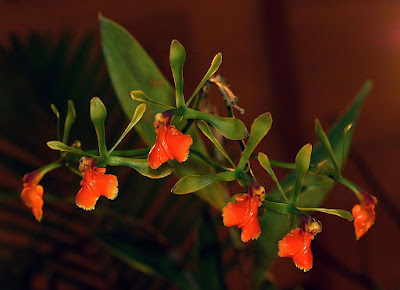Epidendrum pseudepidendrum is native to Costa Rica and Panama. In Costa Rica, this orchid occurs most often in lowland forests and low mountain forests, at the altitudes of 400-1000 m. In Panama, it grows in the Chirique province at an altitude of 1200 m...
Epidendrum pseudepidendrum also called as The False Epidendrum, Pseudepidendrum spectabile, is a species of the genus Epidendrum. This species was described by Heinrich Gustav Reichenbach in 1856.
IDENTIFY EPIDENDRUM PSEUDEPIDENDRUM
Epidendrum pseudepidendrum is native to Costa Rica and Panama. In Costa Rica, this orchid occurs most often in lowland forests and low mountain forests, at the altitudes of 400-1000 m. In Panama, it grows in the Chirique province at an altitude of 1200 m. Although it is quite popular in cultivation, nowadays it is rarely found in nature, mainly from due to the destruction of its natural habitats.
It is a large sized, warm to cold growing epiphytic herb, which reaching 100 cm in height, with cylindric thin, tall, 50-100 cm long and 1.0-1.5 cm wide stems enveloped by tubular, scarious sheaths and carrying a few, elliptic, coriaceous, acute, basally clasping, 5-20 cm long and 2-6 cm wide leaves all held towards the apex.
The False Epidendrum blooms in late winter and early spring on a terminal, loose, semi-erect to arching, to 15 cm long, 3 to 5 flowered raceme arising on a newly mature pseudobulb with several, basal, imbricate bracts and weakly scented, simultaneously opening flowers. The flowers are 4.0-5.5 cm in diameter along the distributed petals of the inner whorl and 5.5-6.5 cm long from the tip of the dorsolateral to the tip of the lip. The flowers look like made of wax or plastic, the petals of both whorls are dark green to apple-green, the big lip is orange to red-orange, and the prone is green at the base and has an orange-red to purple top.
EPIDENDRUM PSEUDEPIDENDRUM CARE AND CULTURE
Cultural information should only be used as a guide, and should be to be adapted to suit you. Your physical location; where you grow your plants, how much time you have to devote to their care, and many other factors, will need to be taken into account. Only then can you decide on the cultural methods that best suit you and your plants.
Light:
Epidendrum pseudepidendrum needs a light level of 30000-40000 lux. The light should be slightly filtered or scattered, and the plants should not be exposed to direct sunlight in the afternoon hours. Strong air movement should be ensured all the time.
Temperature:
It is a plant with moderate to warm requirements. The average summer temperature in the summer is 26-27 ° C, the average night is 17 ° C, which gives a daily amplitude of 8-9 ° C. In winter, average daytime temperatures are 24-25 ° C and at night 15 ° C, with an amplitude of 9-10 ° C.
Humidity:
The False Epidendrum needs the humidity of 80-85% from late spring to autumn, falling to 70% in winter and early spring.
Substrate, growing media and repotting:
Epidendrum pseudepidendrum is easier to grow mounted on tree-fern rootstocks or cork with high humidity and watering at least once a day. During very hot, dry weather, the plants may require several waterings during the day.
These plants are often planted in shallow, hanging pots or baskets filled with loose, quickly drying substrate. The substrate must allow quick root drying after watering. Repotting or dividing the plants should be done when the growth of new roots begins. This allows the plants to acclimatize in a relatively short time and provides them with the least stress.
Watering:
In the period from late spring to autumn rainfall is moderate to heavy. In winter, their quantity drops quite quickly and the 4 months dry season begins until the beginning of spring. The substrate of the plants in cultivation should be moist, and between each watering should only slightly dry out. In late autumn, watering should be gradually reduced.
Fertilizer:
During the active growth, the plants should be fertilized every week 1/4-1/2 of the recommended dose of fertilizer for orchids. You can use sustainable fertilizers throughout the year, but also can use fertilizer with an increased nitrogen content from spring to mid-summer, and then, in late summer and autumn, fertilizer enriched with phosphorus.
Rest period:
In winter, Epidendrum pseudepidendrum need less water. They should dry between waterings, but should not remain dry for a longer period. In most cases, this can be ensured by sporadic fogging in the early morning and light watering once every 2-3 weeks. Watering is most beneficial during bright, sunny weather. Fertilization should be reduced or eliminated until new growths appear and the abundance of spring watering begins.















COMMENTS